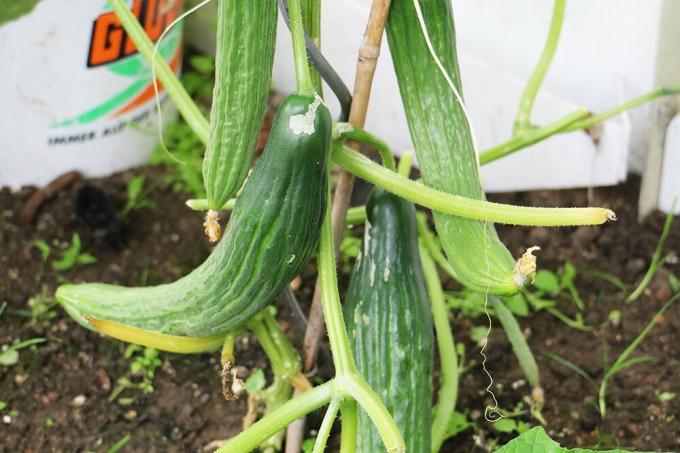
table of contents
- Getting rid of spider mites on cucumbers
- Optimizing the greenhouse climate
- Fighting with water
- Neem oil
- Horsetail broth
- Promote beneficial organisms
- Prevent pest infestation
Spider mites are one of the most common pests on plants. A total of 200 host plants attack them, including 90 cultivated plants that are grown in Central Europe. Cucumbers in sheltered areas such as the greenhouse are particularly plump with them. Here they not only find a good food base, but also optimal climatic conditions to spread. Various options are available to combat the pests on the cucumber plants.
Getting rid of spider mites on cucumbers
Optimizing the greenhouse climate
One reason why the spider mite sticks to Cucumis sativus Rapidly spreading in the greenhouse is the optimal climate. It's dry and hot in greenhouses. Therefore, in the first step, you have to optimize the climate in it. Try to shade part of the greenhouse because the mites love direct sun. This allows you to lower the temperature at the same time. At the same time, make sure that there is a regular exchange of air and that no heat builds up.
Fighting with water
A simple method Tetranychidae / spider mites Fighting on cucumbers is water. This can change the climate from dry to wet, which the mites do not like. Most of them even die due to the damp environment. The problem with this method is that while the insect pests are controlled in greenhouses, when you change to a more humid climate, you favor fungal infections. You should therefore only use water as a remedy against spider mites for a limited period of time.
How to do it:
- Shower the leaves of the cucumber on the top and bottom with lukewarm water
- Wrap the cucumber stalks in a transparent plastic bag
- Remove the bag after two days
- Dispose of the bag in the residual waste

Neem oil
The oil of the neem tree has proven to be helpful in the fight against the mites. Neem oil is available in different forms as a ready-made biological preparation or as a pure oil, for those who want to mix a remedy against the mites themselves. When using the pure oil, it is important that the oil be diluted. To do this, it is mixed with water, which is why an emulsifier such as Rimulgan is necessary for the oil and water to combine. Spray the affected plants with the finished preparation or the self-mixed solution.
Tip: Fertilize with nettle manure, because this strengthens the epidermis of the cucumber plants.
You should refrain from using products made on the basis of pyrethrum in the greenhouse. Although it is a biological agent for combating spider mites based on chrysanthemums, these agents are also toxic to beneficial insects.
Horsetail broth
An effective way of preventing spider mites is to strengthen the plant epidermis. Spider mites damage the plants with their mouthparts, which causes the leaves to turn coppery brown over time. The harder you make it for them to damage the surface, the lower the likelihood that the pests will spread over a large area.

Preparing a horsetail broth:
- Roughly cut the field horsetail
- Pour horsetail into a barrel and pour water over it
- Cover the barrel
- Stir the broth every day for the first week
Tip: If strong smells develop, sprinkle some rock dust on the surface. This reduces odors.
The ratio of horsetail to water should be approx. Be 2: 1. After several weeks, the herb has almost completely decomposed and you can spray the leaves of the cucumbers with it. For use, the broth is diluted 1:10 with water and then the leaves are sprayed on the top and bottom.
Promote beneficial organisms
Damaging beneficial insects would be of little help if the cucumbers were infected by spider mites. There are a number of insects that have mites on the menu. Therefore, the targeted use of beneficial insects can not only be an effective weapon in the event of an infestation, but you can also use it to prevent an infestation.
These insects help against mites on cucumbers:
- Predatory mites (Phytoseiidae)
- Flower bugs (Hemerobiidae)
- Black ball ladybug (Stethorus punctillum)
- Brown lacewing (Hemerobiidae)
- Lacewing (Chrysopidae)

Lacewing in particular of the genus Chrysopidae are an effective weapon against the mites. Lace-ups are available to buy as natural pest control. They are sold in the form of cards containing the eggs. You have to hang these cards in the greenhouse and the larvae will hatch within a very short time. Occasionally the larvae can be bought directly. Both larvae and adult lacewings are efficient at fighting the spider mites.
Prevent pest infestation
In addition to promoting beneficial organisms in the greenhouse, it helps to improve the health of the plants. Regularly using nettle manure or horsetail broth not only ensures that your cucumbers develop well, but also strengthens the epidermis of the plants. This makes it much more difficult for insect pests such as mites to penetrate them.
A mixed culture is also helpful, as it protects the cucumbers and makes the plants less attractive to insect pests. The following herbs are primarily suitable as partners for Cucumis sativus:

- chives
- garlic
- dill
These herbs can be used as underplanting with the cucumber plants and their intense scent has limited insect pests. The herbs also develop well in the warm climate of the greenhouse, where they often have a slightly higher water requirement.

